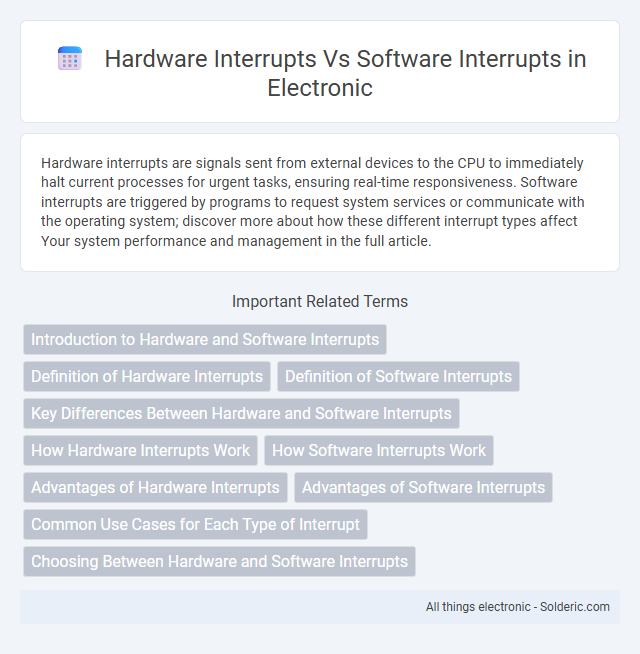Hardware interrupts are signals sent from external devices to the CPU to immediately halt current processes for urgent tasks, ensuring real-time responsiveness. Software interrupts are triggered by programs to request system services or communicate with the operating system; discover more about how these different interrupt types affect Your system performance and management in the full article.
Comparison Table
| Feature | Hardware Interrupts | Software Interrupts |
|---|---|---|
| Source | External hardware devices (e.g., keyboard, timer) | Software instructions or system calls |
| Trigger | Asynchronous signal from hardware | Synchronous instruction execution |
| Purpose | Handle real-time hardware events | Request OS services or exception handling |
| Interrupt Vector | Fixed hardware interrupt vector | Software interrupt vector (often via INT instruction) |
| Latency | Generally low latency for immediate response | Depends on software execution flow |
| Examples | Keyboard input, hardware timers, I/O devices | System calls (e.g., INT 0x80 in Linux), exceptions |
| Handling | Interrupt Service Routine (ISR) triggered by hardware | Software interrupt handler or kernel routine |
Introduction to Hardware and Software Interrupts
Hardware interrupts are signals generated by external devices, such as keyboards or network cards, to immediately capture the CPU's attention for urgent processing tasks. Software interrupts, by contrast, are triggered by programs or operating system instructions to request system services or manage execution flow. Understanding how your system handles these interrupts helps optimize resource management and responsiveness in computing environments.
Definition of Hardware Interrupts
Hardware interrupts are signals generated by external devices to the processor, indicating the need for immediate attention or service. These interrupts temporarily halt the current CPU operations and transfer control to a specific interrupt handler routine to address real-time events such as keyboard input, timer signals, or I/O device requests. They are essential for managing asynchronous events and ensuring efficient interaction between hardware components and the operating system.
Definition of Software Interrupts
Software interrupts are signals generated within a program or by the operating system to request specific services or to handle exceptions and system calls. They allow a controlled method for software to interact with hardware or trigger kernel-level functions without requiring physical interrupt signals. Unlike hardware interrupts, which stem from external devices, software interrupts rely on instructions like INT in assembly language to initiate predefined interrupt routines.
Key Differences Between Hardware and Software Interrupts
Hardware interrupts are triggered by external devices like keyboards or network cards to signal immediate attention, while software interrupts are generated by programs to request system services or manage exceptions. Hardware interrupts rely on physical signals and typically have higher priority, enabling faster response times, whereas software interrupts are executed through specific instructions within the CPU. Understanding these key differences helps you optimize system performance and manage resource allocation effectively.
How Hardware Interrupts Work
Hardware interrupts occur when external devices like keyboards, mice, or network cards send a signal to the CPU, prompting immediate attention to specific events. These signals temporarily halt the current CPU operations to execute an interrupt service routine (ISR), ensuring real-time responsiveness. Your system's ability to handle hardware interrupts efficiently improves multitasking and device communication by prioritizing critical tasks over ongoing processes.
How Software Interrupts Work
Software interrupts work by triggering a specific interrupt request through software instructions, causing the CPU to pause the current execution flow and switch to a predefined interrupt handler routine. This mechanism allows programs to request system services or signal events without relying on external hardware signals. The interrupt handler executes the necessary code before returning control to the original program, enabling efficient and controlled task management within the operating system.
Advantages of Hardware Interrupts
Hardware interrupts offer faster and more efficient responses to external events by directly signaling the processor, minimizing latency and improving system performance. They allow real-time processing of critical tasks such as input/output operations, ensuring that Your system handles urgent priorities immediately. This direct mechanism reduces CPU overhead compared to software interrupts, making hardware interrupts highly effective for time-sensitive applications.
Advantages of Software Interrupts
Software interrupts offer greater flexibility by allowing your programs to handle various system calls and exceptions efficiently without direct hardware reliance. They simplify debugging and error handling by enabling controlled execution flow changes within the software environment. These interrupts improve portability across different hardware platforms, as they abstract hardware-specific details from your code.
Common Use Cases for Each Type of Interrupt
Hardware interrupts are commonly used for real-time tasks such as handling input from keyboards, mice, and network cards, ensuring immediate processor attention to external events. Software interrupts primarily facilitate system calls and inter-process communication by triggering predefined routines within the operating system. These distinctions enable efficient resource management and responsive multitasking in modern computing environments.
Choosing Between Hardware and Software Interrupts
Choosing between hardware and software interrupts depends on the urgency and source of the interrupt; hardware interrupts are triggered by external devices needing immediate attention, making them ideal for real-time response scenarios. Software interrupts are generated by programs for efficient task switching or system calls, allowing your operating system to manage processes without hardware signals. Evaluate the specific application requirements and system architecture to determine the most effective interrupt mechanism for your needs.
hardware interrupts vs software interrupts Infographic

 solderic.com
solderic.com